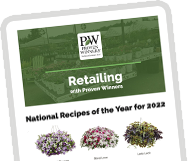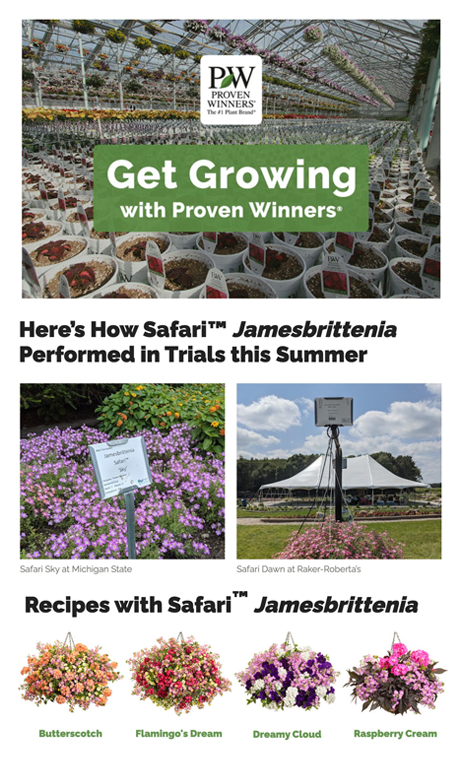Cultural Information Definitions
pH
A: pH 5.5-5.8
B: pH 5.8-6.2
C: pH 6.0-6.5
EC
A: < .6
B: .6-.9
C: 1.0-2.0
Fertilization
N-P-K, 2:1:1.5 with adequate amounts of micronutrients
Ultralow: less than 100 ppm.
Low: 100-150 ppm Constant Liquid Feed
Medium: 150-200 ppm Constant Liquid Feed
High: 200-300 ppm Constant Liquid Feed
Fertilizer Disclaimer:
It is a good practice to clear water leach once every 3-4 times you water to lower soluble salt levels in the media. EC should also be monitored using weekly EC measurements.
Finishing Times
Finishing times are listed in weeks, and estimate the time needed to produce a saleable crop.
Rooting Out Temperatures
These temperatures apply while growing roots to edge of pot. Night temperatures should be run 5º F lower than day temperature.
A: 65-72º/55-65º F
B: 65-72º/65-72º F
C: 65-72º/70-75º F
E: 55-60º/45-50º F
F: 60-65º/55-60º F
Growing On Temperatures
Night temperatures should be run 5º F lower than day temperature.
A: 65-72º/55-65º F
B: 65-72º/65-72º F
C: 65-72º/70-75º F
E: 55-60º/45-50º F
F: 60-65º/55-60º F
Holding Temperatures
For toning crops and/or for when you have to hold a saleable until shipping.
A: 40-50º F (outdoors)
B: 50-60º F
C: Maintain Growing Temperatures
Market Height
?
Light Requirements
High: Full sun crops need very high, bright light
Moderate: Sun to Partial Shade crops, High to
Moderate light
Low: Partial to Full Shade crops, Moderate to low light
Water Requirements
Transplant:
Water lightly to maintain moisture level within root zone until roots reach the side of the finished container. Once roots are developed to the side of the pot see finish watering regime.
Finish Watering Regimes:
A: Dry to Moderate: Water thoroughly without oversaturating, keep moist during root development, allow soil surface to dry completely before watering after the crop is rooted to the edge of the pot.
B: Moderate to Moist: Water thoroughly without over-saturating, keep moist but not wet throughout entire growth cycle.
C: Moist to Wet: Water thoroughly and keep moisture constant throughout entire growth cycle.
Spring Outdoor Finish
Many Proven Winners crops can be finished outdoors under cool temperatures. Finishing under cool temperatures will allow you to expand production area, allows additional spacing inside greenhouse, allows additional turns, and improves quality of the product. Those plants finished outdoors will need additional time to finish. Specific finishing times are difficult to predict due to variability in weather patterns. Outdoor Mum production areas are perfect to use as spring cold temperature finishing space.
Before plants are moved outside they should be acclimated to colder temperatures using holding temperatures stated above.
Ideally plants should be moved outdoors on an overcast day, with moderate temperatures, little wind, and no severe cold (freezing temperatures) forecasted for the next 24 hours. Often a full moon will mean clear skies which will allow temperatures to drop more than expected. To maintain proper nutrition after a heavy rain a light water application with 400-500 ppm N can be used on the already wet plants (this high fertilizer application on dry plants will result in burn).
Plants vary in ability to withstand cold temperature finishing. To help you manage when crops can be placed outdoors we have split our plant material into 3 groups (Not all crops can be finished outdoors and will be noted as No). In the case of unusually cold temperatures you should have frost protection measures ready (frost cloth, sprinklers, or ability to move plants under cover).
It is generally too cold for insects and disease to prosper. You should continue to scout for problems, however, chemical control measures probably won’t be needed. Plant growth regulators will not be needed to control growth.
Growers who wish to try this method of finishing plants should trial a small portion of their plant material the first year to gain experience and comfort. Each year will differ and growers need to be prepared to adapt as conditions change.
A: These plants can be placed outside the earliest. When temperatures are not forecasted to drop below freezing for the next 10 days you should be able to move these plants outdoors. Should the temperature be forecasted to drop below 28º F, protection measures should be taken.
B: This is the second wave of plant material. These plants can be moved outside when odds are that temperatures are much less likely to drop below freezing. Protection measures should be taken for this group when temperatures are forecasted to reach 32º F. Average daily temperatures should be higher than when group A material was moved out. Generally a few weeks after group A is moved out group B can be moved outside.
C: This is the third wave of plant material. These plants can be moved outside when temperatures are no longer likely to reach freezing. A hard frost will cause damage to this group. If a hard frost is forecasted protection measures should be implemented.
Pinching and Growth Regulators
Growth Regulator Disclaimer:
All PGR rates should be trialed by each individual grower before applications are made to entire crop to insure desired results. All rates are given as a spray unless otherwise stated. Summer production may require higher PGR rates when crops are grown indoors. Proven Winners and its affiliates are not responsible for misapplication or misuse of these products. Check manufacturers labels for approved rates and usage recommendations.
Pest and Disease management
Treat with preventative broad spectrum fungicidal drench at transplant. Scout crops regularly (at least once a week) for disease development. Good air circulation, control of humidity, and good sanitation practices are critical. Good sanitation practices include keeping greenhouses clean at all times, eliminating weeds and debris, disinfecting equipment and greenhouses as often as possible, and keeping hose ends off the floor. Good water management practices are critical to healthy plant growth.
Planting and Timing
Plants Per Pot (PPP):
Standard:
4-5”: 1 ppp
6”: 1-2 ppp
Gallon: 1-3 ppp
8”: 3 ppp
10-12”: 3-5 ppp
More cuttings per pot will yield faster finishing times. The higher light and temperatures experienced with summer production will dramatically reduce crop times.




 Sign up for our grower and retailer emails!
Sign up for our grower and retailer emails!
